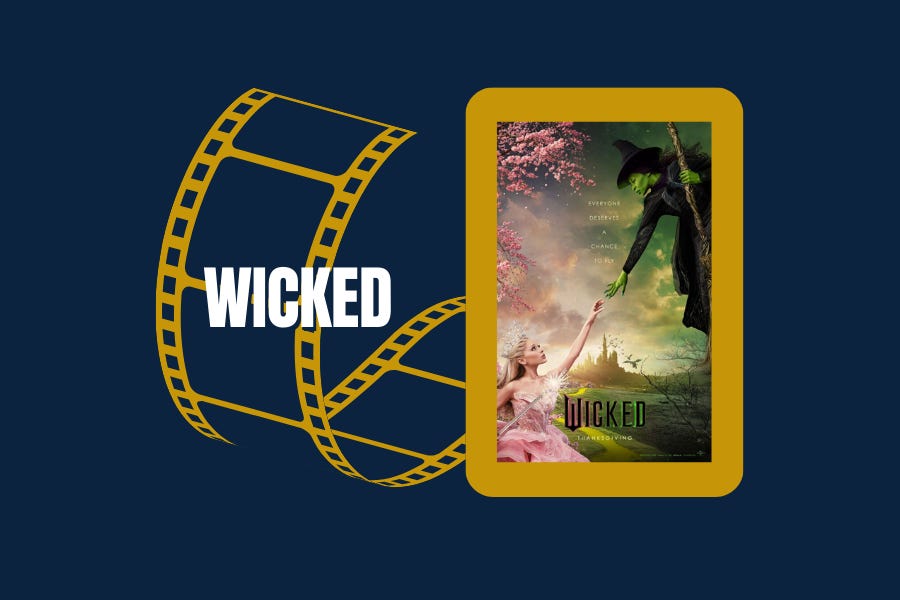The Blue & Gold Shortlist: Our Top Movies of 2024
The nominees for the 2025 Oscars are in. Blue & Gold weighs in.
The 2025 Academy Awards are set for March 2, and the Academy has released their shortlist of nominees. This year’s lineup is studded with stars, surprises, snubs, and fan favorites.
Ahead of the Oscars, Blue & Gold Media staff writer Chloe Newton and guest reviewers Micah Lindley and Anna Robbins share their favorite films from the year — and their thoughts on the nominations — for Blue & Gold’s very own shortlist.
Wicked
reviewed by Chloe Newton
Wicked was an instant, worldwide success when it hit theaters in late November. After months of emotional interviews and heavy marketing, moviegoers traveled back to the Land of Oz with this tasteful twist on a timeless tale. Will the film's success be rewarded at the 97th Academy Awards?
The musical movie was nominated for 10 Oscars, tying for second-most nominations with The Brutalist and following Emilia Pérez, which received 13 nominations.
Cynthia Erivo and Ariana Grande received nominations for Best Actress and Best Supporting Actress, respectively. Grande’s performance as the bubbly Glinda was transformative for the pop-artist and gave audiences an never-before-seen complexity to the character. Though audiences raved about Grande’s excellent portrayal, the two-part release may be her demise, as Glinda’s character has not been fully fleshed out for audiences and critics. Grande may have a better chance of winning at the 98th Academy Awards.
Erivo’s performance as the “enemy of Oz” tactfully navigates the emotional energy that it takes to play a powerhouse role. Despite the dozens of women who have played Elphaba before her, Erivo found new ways to add depth and vibrance to the character that will influence future “Elphies.”
Two other noteworthy categories for which the film was nominated include Costume Design and Production Design. Paul Tazewell, head costume designer, maintained the integrity of Susan Hilferty’s original designs for the stage production. Because films forgo the challenge of real time costume changes, the designs explored new nuances to each character (i.e. the wheat embroidered into Fiyero’s blouse).
Like its predecessor (The Wizard of Oz), Wicked excelled in its production design. In 1939, The Wizard of Oz wowed audiences with the introduction to the technicolor Land of Oz. Production Designer Nathan Crowley and Set Decorator Lee Sandales paid homage to the original film by breaking barriers with its set design feats. The film only used a touch of computer-generated imagery (CGI) to bring the world to life. Munchkinland, the Emerald City, and the poppy fields were built from the ground up, allowing audiences to truly be present in the story.
In a shocking turn of events, Director Jon M. Chu was snubbed for Best Director. Chu was arguably the most devoted individual to this project. For years, fans have wanted a film adaptation of the beloved musical. It was Chu’s commitment to and love of the musical that set the film into motion. There’s nothing scarier to a director than working with source material that is deeply cherished by its long-time audience. Chu managed to build on the elements that the stage production did not parse out yet without deviating from the original magic of the production.
Overall, Wicked revitalized societal thought on movie musicals. This film has potential to popularize (once again) the genre, causing a renaissance in modern films like The Sound of Music, Singin’ in the Rain and Funny Face. Wicked’s success in the box office and at the Oscars may influence production companies to rethink future plans.
Dune: Part Two
reviewed by Micah Lindley
Dune: Part One, the operatic sci-fi space drama directed by Denis Villenevue, released in 2021 to wide critical and audience acclaim. It was the third on-screen adaptation of the book by Frank Herbert, but the first to garner largely favorable reviews. It received six Academy Awards and was nominated for ten. A sequel was officially announced shortly after the release. Dune: Part Two fully lives up to the hype of the 2021 film, going even further in worldbuilding, character arcs, visual effects, and cinematography.
Dune: Part Two picks up immediately after Part One leaves off, with Paul Atreides (Timothée Chalamet) and his mother (Rebecca Ferguson) having joined the Fremen desert people in their fight to free their planet from the invading Harkonnens. The movie proceeds to make commentary on political corruption, religious fundamentalism, and imperialism. Possibly the most masterful part of Dune: Part Two is that it subverts the expectation of the main character being the hero of the story. It is unique for a franchise to build a hero up over two films, only to reveal that he has become the villain of the story.
Villeneuve’s directing style in Part Two is even more distinctive than in Part One, and similar to his previous work on films like Arrival (2016). His taste for massive scale and spacious cinematography fits perfectly into the epic stakes of the Dune universe. The grayscale homeworld of the Harkonnens is stunning and similar to his depiction of the alien visuals from Arrival. The switches between night and day on the deserts of Arakkis are blinding, which makes the contrast between heat and cool almost tangible from a theater seat. On the audio side, composer Hans Zimmer returns from Part One to bring back his thunderous mix of instrumental and electronic scoring. His Part Two score recently won Best Score Soundtrack for Visual Media at the GRAMMYs, though it was snubbed at the Oscars for being “too derivative” of the first film.
While Dune: Part Two has been nominated for several Academy Awards (including Best Picture), it has been snubbed from at least one nomination: Denis Villeneuve was not nominated for Best Director. The Dune franchise is arguably only successful because of Villeneuve’s distinct visual style and directorial choices, and the fact that Part Two has been nominated for Best Picture only speaks to his prowess. Part Two’s directing received praise from other legendary directors such as Spielburg, Nolan, and Cameron, and the Academy’s refusal to acknowledge it is disappointing.
Thelma
reviewed by Anna Robbins
For the past few years, the general consensus of the public has been that we are tired of the same old plots, the same old reboots, and especially of the same old actors. Unfortunately, there has been a shortage of never-seen-before actors, with very few taking any notable risks or breaking the mold.
Luckily for us viewers, June Squibb in Thelma not only breaks the mold – she shatters it. Playing her first leading role at the age of 94, Squibb boldly tells the same story as her movie does: getting older does not have to mean losing yourself or your autonomy.
Thelma is a comedy-action film that follows Thelma as she embarks on a mission to track down the scammers who deceived her. The film also explores her relationship with her grandson, highlighting the similarities in their journeys as they both navigate transitional phases in their lives while searching for their place in the world. With its life-giving messages that resonate with a wide audience, Thelma is a standout movie, and June Squibb delivers a performance that packs a punch.
Squibb’s acting is endearing and would remind any viewer of their own grandmother, adding a tender and emotional layer to the film. She is also confident, self-assured, and assertive – qualities that seniors often lose when they're misunderstood or undervalued. Above all, she is sincere in a way that draws you in. As I watched the movie, I found myself wanting to hear more from Thelma because of her genuine wisdom. She effectively challenges your assumptions and turns stereotypes about older adults on their head.
In my opinion, Squibb deserved an Academy Award nomination for Best Leading Actress. While Thelma earned its fair share of accolades, recognition from the Academy would have been both symbolic and well-deserved. Squibb’s skillful portrayal of Thelma – capturing the experiences of herself and 58 million other Americans as they face harmful stereotypes and the challenges of aging – is truly admirable. Celebrating older adults in the media means rejecting the stereotype of senility and instead honoring the remarkable, unexpected contributions this diverse and rich population offers.











